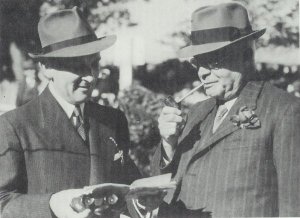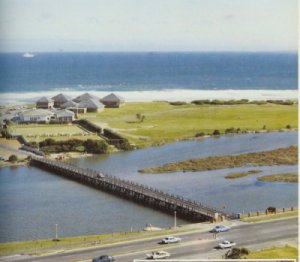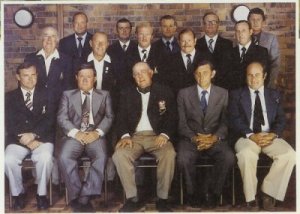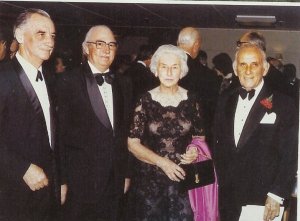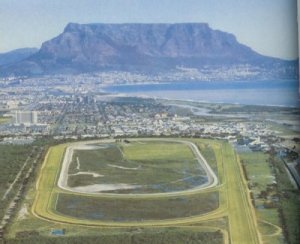|
||
|
Chapter 12 - Housing Schemes
Though still very tiny, Milnerton was already in 1922 assuming the outlines of a community. The truth of this statement was shown on November 11, when Mrs. F. Botha applied "on behalf of the residents for a piece of ground to construct two tennis courts, with a view to forming a Tennis Club". Her request was acceded to and a piece of land in the Park earmarked for the purpose. In addition the Company agreed to advance up to £200 at six per cent per annum "repayable within a reasonable period". About the same time too Sir David Graaff agreed to sell Groot Rietvlei to the Milnerton Estates for £1 437 7s. 6d., in order to round off their holdings.
Following the recent completion of the Steenbras Water Scheme to meet its needs, Cape Town was at last in a position to improve both the quantity and quality of its supplies to Milnerton, through a new main on Koeberg Road. The agreement ran for four years from February 26, 1923, Milnerton Estates accepting a minimum of 2 000 000 gallons a year which could be raised to 6 000 000 gallons, though the maximum for any single day was not to exceed 30 000 gallons.
Revolutionary implications likewise underlay steps taken in the closing days of 1922 when the services of Mr. A. J. L. Thompson were engaged as the first South African Town Planner. Only recently he had been responsible for laying out the country's first Garden City, Pinelands, and on December 20, 1922, he attended a Board Meeting to discuss the future lines of Mi1nerton's development. "Existing roads," Thompson pointed out, "will be utilised as far as possible, and I will only advocate making new ones, where warranted, by the actual building operations." He also explained the two courses open with regard to building - "either the company can put up the money or it can form a subsidiary to buy plots and erect houses". After undertaking to furnish further details on the alternatives, Thompson handed in plans and specifications for "three specimen houses of average proportions". Sure enough, Graaff announced, on January 11, 1923, that the directors were "considering a Housing Scheme and the advisability of raising money for developing the estate". As for Thompson, his name was not mentioned, though Sir David described him as "a gentleman of repute regarding the development of the estate", indicating that it was hoped soon to reach an agreement.
Among the ideas put forward by this consultant was the establishment of a Country Club, of which an important sponsor was Major Brand van Zy1, a leading Cape Town attorney and afterwards Governor-General of South Africa. The proposal was approved early in 1923 and simultaneously another novelty made its appearance when a Mr. Fripp became the first occupant of an official camp site at Milnerton.
Giving as the their reason the "contemplated development of the Estate", the management now decided to engage a full-time Secretary, Gordon Bird, while the registered office of the Company was moved from Cape Times Buildings to the township itself, with effect from February 1, 1923. Changes were also taking place at the Milnerton Race Course, where the original Milnerton Turf Club Company Limited was liquidated and the lease taken over by its successor.
For the first time too there was a definite proposal for establishing a local Administration, the duties of which had in practice been carried out by the Board of the Milnerton Estates Company Limited. Here the initiative was largely due to a director named Hector McKenzie, who on April 19, 1923, cross-examined Thompson on the function of a Local Board. Among the advantages emphasised by the Town Planner was the fact that such a body would have the right of levying a Rate of up to 3d in the Pound for purposes of Road Maintenance, Repairs, Removals, the Disposal of House Refuse etc. It would also see to Water and Electric Light and could enforce its regulations regarding Sanitation etc. "I am however of the opinion", added Thompson, "that a Local Board would not have the power of taxing unsold plots of the Company on which no buildings have so far been erected"
Further encouragement was furnished by the willingness of the Cape Town City Council, to make advances to Milnerton, provided its pending application for a loan from the Government Housing Authority proved successful. Here an amount of £30 000 was mentioned, to be used for the erection of cottages. Before the year ended, Milnerton Estates were actually putting up houses for resale, under the supervision of Thompson, all of a standardised pattern. By February 18, 1924, there was already talk of the purchase, by Mrs. Malan of Stellenbosch, of one of them (Type A), for which the mortgage rate of eight per cent per annum was charged. Unfortunately there were hitches, and in May 1924 it was reported: "Building plots are not selling as readily as anticipated, and none of the houses built by the Company have yet been sold". This fact, combined with the slowing down in the development of the whole township, led to the decision to terminate Mr. Thompson's services, though not before he had completed the plan for the general layout of the Estate and of the proposed Country Club.
Another piece of bad luck was encountered when, on December 3, 1924, a newspaper reported the proposed establishment of "a Country Club at Newlands". Suggestions followed of an alternative site at Milnerton, but in the event, not even the availability of a golf course would make the sponsors change their minds. Once again Sir David Graaff did his best to help the interest of Milnerton, by including, amongst others, the Mayor of Cape Town to pay a personal visit to the suggested site. But Kelvin Grove won the day.
In contrast to this was another project, with which Graaff was linked through Governmental channels, namely the establishment by the Marconi Company of South Africa of a huge international wireless receiving and transmitting installation. Discussions began in May 1923 about a 10 morgen site near Ascot Station and the Race Course and here presently arose the famous Klipheuwel Beam Station, for many years South Africa's major link with Europe. With changing radio techniques, however, the Beam System was ultimately replaced by other methods, and the huge masts, after many years of service, were ultimately demolished.
The rising population slowly brought increase in the Milnerton train service, yet its returns continued too low to yield a profit. Advertising was resumed to stimulate the sale of plots, while it was learnt with much satisfaction that no less than £17 000 had been spent by the Turf Club on additional buildings at the Race Course. New residents recorded in 1934 were W. S. Caw, plumber, S. Harris, carpenter, and F. Botha, the Secretary of the Milnerton Turf Club.
About this time too fresh possibilities for expanding the township were brought about by the efforts of A. W. Koenig, who owned an area next door, known as Rugbyville. Though actually a hotelkeeper, he had ambitions of creating a new township which he hoped would become part of Milnerton Estates. The price he asked was not a very high one £5 000 for 1 000 plots. The Company succumbed to the temptation.
Besides his land speculations Koenig was not only responsible for the erection of the first block of flats near the Cambridge Hotel (incidentally equipped with the earliest recorded septic tank), but he pioneered the idea of a motor bus service along the Marine Drive, "at such times of the day as there are no trains". While refusing to finance or participate directly, the Company had no objection to Mr. Koenig going ahead.
In more than one respect the year 1925 brought a certain amount of stimulus to the progress of Milnerton, one of the most important incidents being the acquisition, from the deceased estate of H. C. F. van Niekerk, of a very substantial 256 morgen on Koeberg Road for £2 800. Apart from the direct enlargement of the Company's own holdings, this put a stop to the sale of nearby land without restrictions on the quality of buildings.
As against this a new 30-year lease was granted to the Milnerton Golf Club at a peppercorn rent of one guinea per annum. In return the Company contributed £1 500 towards the cost of a Golf House.
The rising popularity of the Course prompted the Company in April 1926 to raise the amount of its gift to £2 000, besides a loan of £3 000, repayable at the rate of £120 per annum.
For the first time there were now official and separate figures regarding Milnerton's population, the 1926 census giving 247 Europeans, of whom 107 were listed in the Directory. The area, however, could scarcely be regarded as undergoing a land boom. In Rugbyville the basic price of 5000 square foot plots was fixed at £25 with those on corners slightly higher!
Symptomatic of the growing population was the increase in traffic on the new Marine Drive. But T. S. McEwan, who, since his retirement as General Manager of Railways, had come to live in Milnerton and was now also on the Company's Board, warned that the vehicles were too heavy for the surface and that much damage was being done. "If the hard road to Ascot is reconstructed 'as contemplated, it will only invite similar heavy traffic, and experience now gained has led to a decision to abandon such construction for the present. A well-built road, having a solid bottom, will probably cost from £4000 to £5000 per mile, which the Company cannot undertake at the present juncture."
So too the directors frowned at the idea of the Turf Club's offer to buy their racecourse at £15000. One of the few who recommended such a deal was R. B. Howes, the well-known K.C. and afterwards Judge. He thought this amount could be used to finance "a building loan scheme", and suggested that the sale should be made conditional on the Company's repurchasing the ground "if racing should ever be discontinued or if it be required for building plots". Finally it was agreed. "The time has arrived for carrying out a policy of energetic development on Milnerton Estates. For that purpose: 'A. A material reduction on the price at present charged for building lots on the Estates should be granted to desirable purchasers, who intend to erect buildings upon such lots in the course of time. B. Such reductions should be increased up to 50 per cent if the purchasers undertake to build decent houses within a reasonable time. C. Building loans should be granted by the Estate up to two-thirds of the cost of buildings to be erected, with interest of about six per cent, repayable in instalments on building society terms.'"
Following the acquisition of "Rugbyville", a policy of tree-planting was promptly commenced there, particularly eucalyptus. One of the first applicants for land after this transaction was the well-known pioneer storekeeper, Charles Greig, already living there, who wanted to erect an interdenominational place of worship. While the idea itself was accepted, its realisation was postponed.
Simplicity of conditions at Milnerton Estates was again reflected in a letter from A. W. Koenig, the hotelkeeper, who on November 25, 1925, sent in an application "on behalf of Milnerton residents", for a loading platform for goods and livestock, besides a station attendant, sanitary conveniences and a few seats on the passenger platform.
|
||
|
|
||

